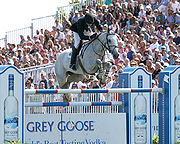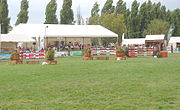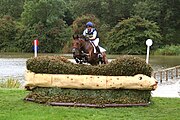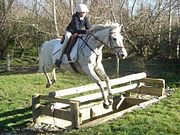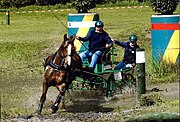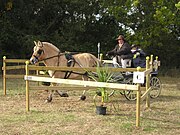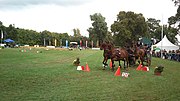Obstacle (equestrian sport)

There are obstacles in several equestrian disciplines. There are obstacles that must be jumped, such as show jumping, hunting, and eventing and obstacle racing. But there are also step and trot cavalettis or poles that can be overcome in the appropriate gait without jumping. Driving sport obstacles must be passed.
- Part of a cross-country course in eventing
- Obstacle on a racecourse for hurdles racing
- Obstacle on a horse racing track for hunting races
- Obstacle on a hunting route while hunting riding
- Obstacle in driving sport when driving obstacles (cone driving)
- Obstacle in driving sport when driving off-road (marathon)
- Skill course for serenity tests , ground work and western riding for the trail discipline
Obstacles to driving , show jumping and versatility are described below.
General
All equestrian obstacles should be designed in such a way that the risk of injury is low. One danger is that a horse will step on a pole lying on the ground because a pole has rolled in the wrong place. This is why poles should be secured against rolling away and the correct spacing should be ensured.
Mostly heavy, stable and solid obstacles are preferred. However, many young girls and other physically less capable people ride who have already reached the limit of their strength with a damp wooden pole. Spruce wood with a normal residual moisture content of 15% has a density of around 400 kg / m³. This means that a rod four meters long and ten centimeters in diameter already weighs 12 kg. Obstacle stands, especially catch stands, are much heavier, especially if they have perforated iron rails for the jump pads. That is why more and more light obstacles made of aluminum or shatterproof plastic are used. A reliable horse may successfully use two “ pool noodles ” attached to one another instead of an obstacle bar, provided the pool noodles are securely clamped. This is not recommended when training young horses. For floor work, plastic-coated, soft, foam-rubber-like elements are often used, which give way when stepped on. They are placed on the floor or stacked on top of each other. Alternatively, 3 m long bars with a diameter of 8 cm, which weigh only around 6 kg, can be used together with lightweight aluminum stands.
Obstacle poles and stands must be stored protected against moisture so that they do not soak up, become even heavier and rot . The wood needs to be treated. Mostly they are first primed white and then given a colorful coat of paint.
Show jumping obstacles
The course obstacles for jumping competitions are made of movable material.
Obstacle poles are mostly made of wood, but can also be made of plastic. They are 3–4 m long and have a diameter of 8 to 10 cm. The weight and diameter of the bars play an important role in competitions. The lighter a rod, the easier it is to throw it off. The smaller the diameter of the bars, the more delicate the obstacle appears. It is less noticed and less respected by the horse. As a result, horses tend to jump more negligently and make mistakes.
The space between the bars and the earth should not be empty. For example, a plank can be hooked into the stand at the bottom, a brush or other elements can be placed under the bars as an underpinning. For the horse, a filled jump is easier to assess than a single pole floating freely in the air. Obstacles in strong colors are perceived better than inconspicuous colors.
The bars are each supported by two stands. The stands should be stable and not too light so that they do not fall over with every draft. Height-adjustable brackets, the so-called supports, on which the bars are placed, are attached to the stands. The supports have a concave, hollowed-out support surface into which the rods are placed. With deep supports, the poles lie more firmly and are not thrown off so easily; with flat supports, the poles fall more easily. For international competitions, the depth of the requirements is prescribed. At least two jumps are set up on the exercise area for jumping competitions, a steep jump and an oxer.
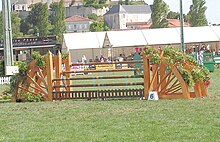
In the bar work the rods are placed on the floor and secured if necessary against rolling.
In competitions, the obstacles are marked on the right with a red flag and on the left with a white flag, indicating the direction in which they have to be jumped. The number is placed in front of the red flag, i.e. on the right side of the obstacle. The numbers indicate the order of the obstacles.

Catches are usually placed on both sides of the jumps. They help the horse concentrate on the obstacle and not move sideways. In tournaments, the catches are usually widened with flowers, trees and other decorative elements. With the help of the flower arrangement, a certain path can be specified. Sometimes horses are frightened of unexpected decorative elements. In international competitions, the course builders compete for the most original possible design of the jumps and the course.
Steep jumps
A steep jump is built from two stands, poles, planks and other movable material.
- A cross is lower in the middle and directs the horse to jump in the middle. Crosses are very popular in training and education. The horse can be guided by bars on the ground in front of, under or behind the jump. A bar on the ground under the jump makes it easier for the horse to judge. A service bar about 3 m in front of the jump helps the horse start the jump. A bar at the right distance after the jump forces the horse to pay attention again so that it cannot storm away after the jump.
- A rick is just made of bars.
- Planks are wider and more conspicuous than bars and can irritate horses if they are new to planks as jumps. On the other hand, they appear more massive than poles, so that the horses show more caution when jumping and the risk is lower than with poles that sloppy front legs lead to a throw. Planks are firmer in the supports so that they are less easily thrown off. For this reason, a pole is usually used at the top, or very flat surfaces so that even a plank can easily fall.
- A wall consists of opaque wall parts that can be varied in height depending on the structure. A wall is opaque, so the horses cannot see what is directly behind the wall. If there is a lack of trust, walls are more likely to be refused than other obstacles. If the horse jumps the wall, it is seldom torn, as the massive appearance leads to a lot of caution with the horses.
High jumps
A high jump is usually built from four stands, poles, planks and other movable material.
- In an oxer , the front and rear bars are the same height. The highest point of the jump curve is in the middle between the two bars. During training, the rear bar is often placed a hole higher and is therefore easier to see for the horse. In the case of an oxer, there is only one pole on the rear pair of stands. He may only jump in the intended direction.
- A double rick consists of two ricks of equal height .
- Triplebarre: consists of three ricks that rise in height. The trajectory must therefore have the highest point above the last pole and not in the middle above the jump.
- Verdener Bank ( Cavaletti or low pole before steep jump)
- Hogback : also called pig back, roof-shaped obstacle
- overbuilt moat, also Liverpool : steep jump or oxer over a moat. The moat can be dry and only consist of the blue plastic material. The horse is tempted to look down and is less aware of the obstacle. Rider and horse have to be appropriately concentrated.
Long jumps
- A water ditch in a jumping course is a shallow tub filled with water. When a horse steps in the water, it splashes and makes waves. This will recognize the error. There are water ditches in various widths, from 1 m to 5 m for difficult jumps. There is usually a brush in front of the moat to draw the horse's attention. After the moat, the ground is usually adapted, for example sand is piled up so that the horse does not step on the bulge of the tub. A moat usually consists of a blue fabric-reinforced PVC tarpaulin and a flexible bead running around it that is approximately 10 cm high. Such a plastic moat is easy to assemble and dismantle. A permanently installed moat is usually made of heavy, black or blue solid rubber, which does not slip as easily and is more durable.
combination
A combination consists of several jumps with one or two gallop jumps between them. A combination of two jumps is called a double combination, and a combination of three jumps is a triple combination. A combination has only one obstacle number. The partial obstacles are designated with the letters A, B and C.
In a derby , special combinations of obstacles, such as powder man's grave, are built up.
In-out
If there is no gallop between the jumps, so the horse has to jump off again immediately after landing, they are called in-out. In-outs must not be too high. The horse can jump two in-outs with momentum, with longer rows of jumps the horse has to work more and more with the hindquarters. The jump series must therefore be tailored to the condition of the horse. Simple in-outs are, for example, gallop cavalettis.
In-outs are particularly popular in gymnastics series and free jumping , as they train the sense of rhythm and train hasty horses to concentrate.
Obstacles in eventing
In eventing , obstacles made of colored, loosely attached poles of the same type as in other jumping are used in the jumping sub-test.
When country riding degegen solid terrain obstacles that usually a rustic, bulky or natural appearance have to be overcome must, for example, trenches, walls, fences, water crossings or tree trunks. Additional requirements are climbing up or downhill.
In the case of difficult stretches of particularly difficult passages, there are usually two alternative routes to choose from, one of which is less demanding, but takes more time to overcome and is colloquially called the chicken way . In this way, the rider can independently adapt the route to the form of the day, as well as the strengths and weaknesses of his horse. There are obstacles, the connections of which give way under a certain load or can be easily removed manually. This is to limit the consequences of falls and facilitate rescue.
Bank
Benches are steps where a difference in height has to be overcome. It can be a single step or a staircase with several steps.
hedge
Hedges are available as a brush or bullfinch.
Brushes are constructed from a solid substructure with attached brushes, so low that the horse can see overhead. You will jump through the brush in a flat arc, not over it. Brushes are also used in obstacle races . Sometimes the substructure is camouflaged in such a way that it resembles the brush.
With the bullfinch, the brush is so high that the horse can neither see through nor jump over it; it wipes through the hedge. The horse's confidence in the rider is put to the test because it cannot see the landing and jumps against a hedge that looks closed.
Coffin
A coffin is a 15 meter long combination of obstacles with a depression. The jump is made downhill into the depression, at the deepest point there is an open ditch, then the jump is jumped out of the depression uphill. A coffin is ridden in at a set, assembled gallop so that the horse has enough time to assess the obstacles. The horse can react more freely with the forehand when the hindquarters have taken on more weight.
Owl hole
An owl hole is an obstacle with a solid base and a high wall of twigs with a hole in the middle through which to jump.
dig
There are simple and overbuilt trenches. Trenches should be broken energetically with an extended gallop jump.
A Trakenergraben is a trench overbuilt with a bridle. Trakehner trenches were drainage trenches with an electric fence. Since the main stud Trakehnen in East Prussia was largely located on moorland and swampy terrain , large-scale drainage ditches had to be dug on the pastures in the 18th century . In 1973, Rachael Bayliss and her horse Gurgle the Greek overcame the Trakehner Trench at the Badminton Horse Trials by slipping under the fence. After that, the rules were adjusted so that the obstacle must be overcome not only between the flags, but also above the pole.
Normandy Bank
A Normandy bench consists of an open moat that lies directly before a landing on a bench.
Since this is a difficult obstacle that not only requires a vigorous jump over the ditch and onto the bench, but also an obstacle on top of the bench and a quick downhill jump, this obstacle is usually only queried in more difficult versatility.
Narrow elements
Narrow elements are narrow obstacles that require a precise and straight approach, as it is very easy for the horse to evade and run past the obstacle to the side. As the degree of difficulty increases, more and more narrow elements are built into the cross-country course as an obedience test, since in this way the starting field can be tested without increasing the risk or stress on the horses.
Sunken road
A Sunken Road is a mountain jump and a mountain jump in quick succession. In addition, in the case of a higher degree of difficulty, a gallop jump before the downhill jump and a gallop jump after the uphill jump can be built in. This makes a Sunken Road a very technical obstacle that requires precise division. If the approach is poor, or if the gallop jumps are too big or too small, the distances are no longer correct, which can lead to refusal. The quick change from high jump, hill jump, hill jump requires a good balance of rider and horse so that the rider can move smoothly and always remains exactly above the horse's center of gravity.
Pork loin
A pig back is a massive high jump where the obstacle is highest in the middle. This obstacle is also called the hogback , after a historical type of Viking Age tombstone found in the British Isles .
water
There are water hazards from simply crossing the water to complex combinations with obstacles when jumping in, jumping out or islands in the water with other obstacles.
Since the horse is braked strongly in the water, water hazards must be ridden differently than obstacles without water. When jumping in, care must be taken to keep yourself upright so that your balance is not lost despite the braking effect of the water. The horse's gallop jumps are shortened by the water. Jumps in the water must be ridden energetically. In addition, some horses shy away from the water because they cannot see the ground. A corresponding amount of trust between rider and horse is necessary.
Obstacles to driving
Obstacles when driving off-road
There are special driving obstacles, for example water obstacles or mechanical obstacles / dry obstacles, on marathon routes for off-road driving or on driver training courses. The obstacles are usually built from sturdy wooden posts and poles. If possible, the natural terrain is included by building the obstacles around trees or on the slope. Tunnels or bridges can also serve as obstacles. There are artfully designed obstacles at large events. In most cases, however, permanently installed obstacles are more complex than those that are only built for one event.
Obstacles in obstacle driving
When driving through obstacles or cones, you drive as quickly as possible through a course with goals made of pairs of cones. Balls lie on top of the cones and fall when touched (error). The gates are only a little wider than the track width of the cars. The pairs of cones must be traversed in the correct order as quickly as possible and without errors. In the " hunt for points ", the various obstacles on the course are worth different amounts of points. The aim is to collect as many points as possible in a certain time. The number of points for each obstacle is indicated on a board by the right cone. Each obstacle can only be passed twice, regardless of the direction. An obstacle that was started within the permitted time may still be completed, after which the finish line must be crossed directly. One possible strategy is to tackle the most difficult obstacle with the highest score at the end, since this obstacle takes the most time.
Web links
Individual evidence
- ↑ Bathing noodles as obstacles , versatile use of swimming noodles and crawling tunnels as obstacles for horses, Swiss Horse Agility
- ↑ Dual activation
- ↑ Roland Boost: Creative Cavaletti Work: More variety in everyday training . BLV Buchverlag, 2014, ISBN 3-8354-1230-2 , S 28, chapter "Cavaletti simply made yourself"
- ↑ Steep jump with handrail , FN video
- ↑ Wassergraben , Beck + Heun - Equestrian Manufactory
- ↑ The site structure , Equestrian Sports Association Schleswig-Holstein eV (PDF)
- ↑ spiegel.de June 15, 2014: Fatal fall in eventing: “There will never be one hundred percent security” , interview by Olaf Stampf with Martin Plewa
- ^ Riding from Coffin Situations , FN video
- ↑ "Equestrian Eventing" , Local Riding
- ^ Normandie Bank , Austrian Equestrian Association , OEPS
- ^ Water , Austrian Equestrian Association , OEPS









